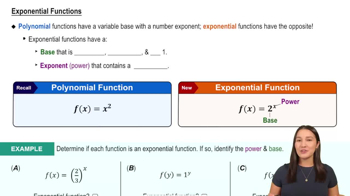Table of contents
- 0. Functions7h 52m
- Introduction to Functions16m
- Piecewise Functions10m
- Properties of Functions9m
- Common Functions1h 8m
- Transformations5m
- Combining Functions27m
- Exponent rules32m
- Exponential Functions28m
- Logarithmic Functions24m
- Properties of Logarithms34m
- Exponential & Logarithmic Equations35m
- Introduction to Trigonometric Functions38m
- Graphs of Trigonometric Functions44m
- Trigonometric Identities47m
- Inverse Trigonometric Functions48m
- 1. Limits and Continuity2h 2m
- 2. Intro to Derivatives1h 33m
- 3. Techniques of Differentiation3h 18m
- 4. Applications of Derivatives2h 38m
- 5. Graphical Applications of Derivatives6h 2m
- 6. Derivatives of Inverse, Exponential, & Logarithmic Functions2h 37m
- 7. Antiderivatives & Indefinite Integrals1h 26m
- 8. Definite Integrals4h 44m
- 9. Graphical Applications of Integrals2h 27m
- 10. Physics Applications of Integrals 2h 22m
4. Applications of Derivatives
Motion Analysis
Problem 6.R.11a
Textbook Question
{Use of Tech} Decreasing velocity A projectile is fired upward, and its velocity in m/s is given by v(t) = 200e^−t/10, for t≥0.
a. Graph the velocity function, for t≥0.
 Verified step by step guidance
Verified step by step guidance1
Understand the velocity function: The given function is v(t) = 200e^(-t/10), where v(t) represents the velocity of the projectile at time t. The function is an exponential decay function, indicating that the velocity decreases over time.
Identify the key features of the function: The initial velocity at t = 0 is v(0) = 200e^(0) = 200 m/s. As t increases, the term e^(-t/10) decreases, causing the velocity to decrease.
Determine the behavior of the function as t approaches infinity: As t becomes very large, e^(-t/10) approaches 0, which means the velocity v(t) approaches 0 m/s.
Choose an appropriate range for t: Since the problem specifies t ≥ 0, consider a range of t values from 0 to a reasonable upper limit, such as 50 seconds, to observe the behavior of the velocity over time.
Plot the graph: On a graph, plot v(t) on the y-axis and t on the x-axis. Start at the point (0, 200) and show the curve decreasing towards the x-axis as t increases, reflecting the exponential decay of the velocity.
 Verified video answer for a similar problem:
Verified video answer for a similar problem:This video solution was recommended by our tutors as helpful for the problem above
Video duration:
3mPlay a video:
Was this helpful?
Key Concepts
Here are the essential concepts you must grasp in order to answer the question correctly.
Exponential Functions
Exponential functions are mathematical expressions in the form of f(t) = a * e^(kt), where 'e' is the base of natural logarithms. In the context of the given velocity function v(t) = 200e^(-t/10), the negative exponent indicates that the function decreases over time, which is typical for projectile motion as it loses velocity due to gravity.
Recommended video:

Exponential Functions
Graphing Functions
Graphing functions involves plotting points on a coordinate system to visualize the relationship between variables. For the velocity function v(t) = 200e^(-t/10), the graph will show how the velocity decreases as time increases, illustrating the projectile's deceleration. Understanding how to interpret and create these graphs is essential for analyzing motion.
Recommended video:

Graph of Sine and Cosine Function
Velocity and Time Relationship
The relationship between velocity and time in projectile motion describes how the speed of an object changes over time. In this case, the velocity function indicates that as time progresses, the velocity of the projectile decreases exponentially, reflecting the effects of gravitational pull. This concept is crucial for understanding the dynamics of motion in physics.
Recommended video:

Derivatives Applied To Velocity

 6:29m
6:29mWatch next
Master Derivatives Applied To Velocity with a bite sized video explanation from Nick
Start learning



